

The intention is to cover in detail all of the post CBS versions of the US made standard Stratocasters. A huge amount of
research has been done by John C of the strat forum blkstrt from the same forum has done some work on the logo and headstock
differences both have very kindly allowed my to copy their work. Thanks guys it takes hours and hours of work to produce what you have
produced. I have a separate CBS page and pre CBS is covered by many great books.
Notes in italics are added by myself, other strat talk members or from correspondence
1986: American Standard models are designed; at least the Strat goes into production toward the end of the year (between October
and December).
Some of the first American standards came with wood screw posts instead of metal inserts. Mr Dunlop strat talk
1987: The American Standard Strat is officially introduced at the January NAMM show.
The specs are:
22-fret maple neck with either a maple or rosewood fingerboard
medium jumbo frets, 9.5" radius, 1 11/16" nut width.
Sealed tuners
3 "American Standard" alnico 5 single coils - flat polepieces, all the same output level.
Tone control 1 is a standard pot wired to the neck pickup; tone control 2 is a TBX control wired to both the middle and bridge pickups.
2-post tremolo with cast steel saddles in a satin finish.
2 modern-style string trees, synthetic bone nut.
Available in multiple finishes. Alder body for most colors, Ash for certain transparent finishes
(specifically clear/natural, 2-color sunburst, a few others depending on year).
Body has the universal/swimming pool rout.
Silver modern logo with serial number on the front of the headstock. FMIC uses up old serial number decals with E3xxxxx
and E4xxxxx numbers.
Neck plate has the modern "Fender" logo etched into it at an angle.
Case for that era was a rectangular molded plastic case.
Circa March 1987 - body contours change from the deep ones similar to the AVRI guitars to the less rounded edges. But note
that no 1986-July 2000 American Standard ever had the "Original Contour Body" decal.
July 1988: E3/E4 decals used up; move to E8 decals
November 1989: E8 decals used up, move to E9 decals


Fall 1990: E9 decals used up; mistakenly use N9 decals (actually the "E" or "N" is one decal; the other 6 numbers are the second
decal; Fender starts using the "N" prefix decal but keeps using "9xxxxx" number decals. It is corrected and N0 decals are used in
late 1990
Circa 1991-1992: The case changes to a chainsaw/guitar shaped gray case
Circa 1991: Due to a shortage of alder many bodies are now poplar with alder veneers. Even on alder bodies veneers used on
transparent finishes like 3-color sunburst.
1995: Change to the vintage-style headstock decal; serial number decals move to the back of the headstock. Also serial number
decals get close to being "on track" as they begin using N5 decals in early 1995. Poplar bodies phased out, but still use veneers on
sunbursts/transparent finishes


1997: Change to Delta Tone system - the bridge pickup is now wound hotter than the neck/middle pickups; TBX tone control is replaced
with the no-load tone control (still wired to the middle and bridge pickups)
Around this time CNC holes started appearing on the bodies Mr Dunlop strat talk
The only thing I can add via my own 1997 AM Standard which I purchased new, is.. the case was a black (not grey)
chainsaw style, with the Fender red label. Mr Lefeurve strat talk
1998: Begin to transition into the HSH routing - first appears on new colors introduced in the summer of 1998 like transparent
orange
1999: by the end of the year most will have the HSH routing; also begin to see the revised neck plate with the vintage-style
"Fender" logo etched into it horizontally, with "Corona" and "California" on the 2 lines below the "Fender" logo
Circa April/May 2000: production on the American Standard ceases.
July 2000: The American Series replaces the American Standards. Many small changes/updates from the previous model -
neck gets rolled fingerboard edges, staggered-height tuners, and a change to 1 string tree. Body gets the more rounded edge
contours, allowing the return of the "Original Contour Body" decal. New alnico 5 pickups with staggered-height polepieces
(a modernized stagger for the typical .009 or .010 string set). Elimination of any veneers on the alder bodies.
Plastic changes from white to parchment, but some colors will get black plastic hardware (but the black plastic is more
prevalent on HSS and HH models). Other features remained the same, including the Delta Tone system of higher output bridge pickup
and no-load tone pot. Case changes to black plastic chainsaw-type case.
2001-2007: Really only color changes. At some point the Schaller straplock buttons are replaced by standard strap buttons,
and toward the end of the run the tuners change from Schaller to Ping (but still the same design).
Fall 2007: Fender ceases production on American Series models to transition to the 2008 American Standard models.
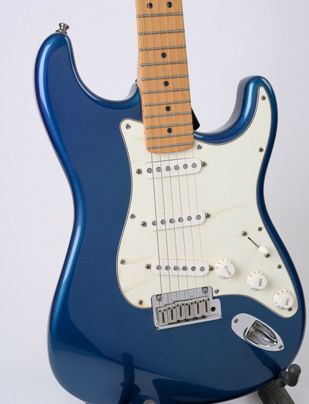
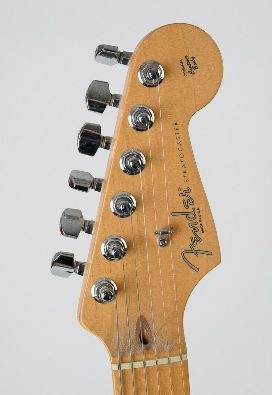
2008 American Standard Specs
Body Alder Gloss Urethane Finish
Neck Maple Gloss front Satin back with Maple or Rosewood Board
22 Medium Jumbo Frets
Headstock small gold modern logo 1 modern string tree
Pickups American Standard Alnico V
Tuners Deluxe Cast Sealed Staggered
Bridge 2 point Sync trem with bent steel saddles and high mass block
Headstock Small 1 string tree
Delta Tone No Load system
Molded Rectangular Fender Case
Fender made more incremental changes to the other Strat models during this era - particularly the HSS and HH models,
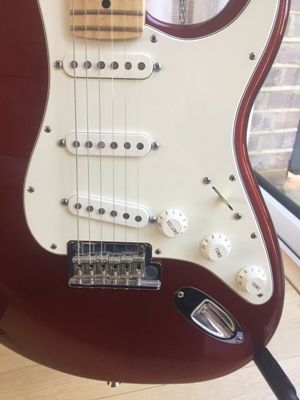
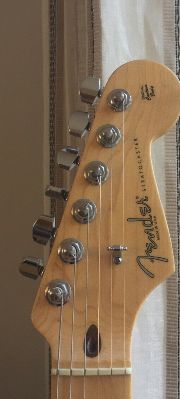
December 2016: The American Professional model replaces the 2008-2016 American Standard. There were several major changes -
starting with a new neck shape that has more shoulder and also gets deeper down at the 12th fret. The tremolo now has a
push-in arm instead of a screw-in arm. New Tim Shaw designed Vmod pickups that are different in each position -
the neck has a mix of alnico 2 and alnico 3 polepieces, the middle has a mix of alnico 2 and alnico 5 polepieces,
and the bridge has all alnico 5 polepieces. The no load tone pot is replaced by a normal tone pot; a treble bleed circuit is
added. New molded case that debuted with the American Elites at the start of 2016 is now used.
Since then there have only been some colour changes.
Serial Numbers
From what I've been able to track down it's part of Fender being so far off-track with the serial numbers. It was kind of like
this for Strats (other models started production later, maybe had more E3s, etc.):
E3 and E4 - used from the start of production at the end of 1986 until circa June/July 1988
E8 - circa June/July 1988 until fall 1989
E9 - fall 1989 until Fall 1990
N9 - the "mix up" goes fall 1990 until some time in 1991 - which we now know goes to at least April from yours,
maybe later until they got to the N0
As far as I can tell Fender didn't get the serial numbers on track until the mid-1990s - maybe 1995, when they changed
from the modern decals with s/n on the front to the vintage-style decals with the s/n on the back of the headstock.
here's some minor decal differences i have noticed on recent American Std/Pro (2008-2018)
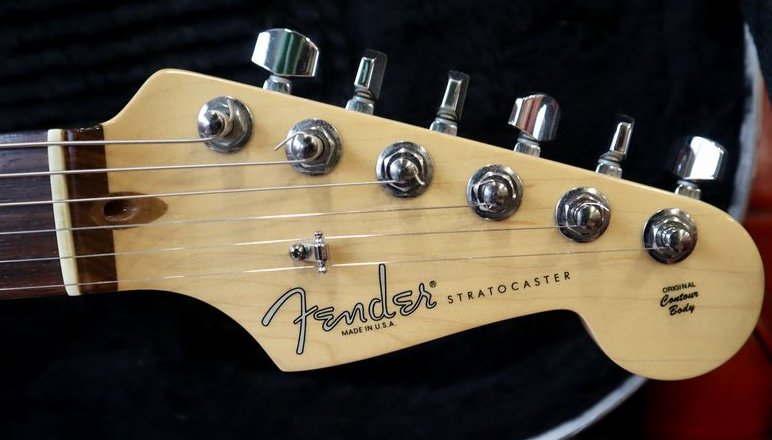

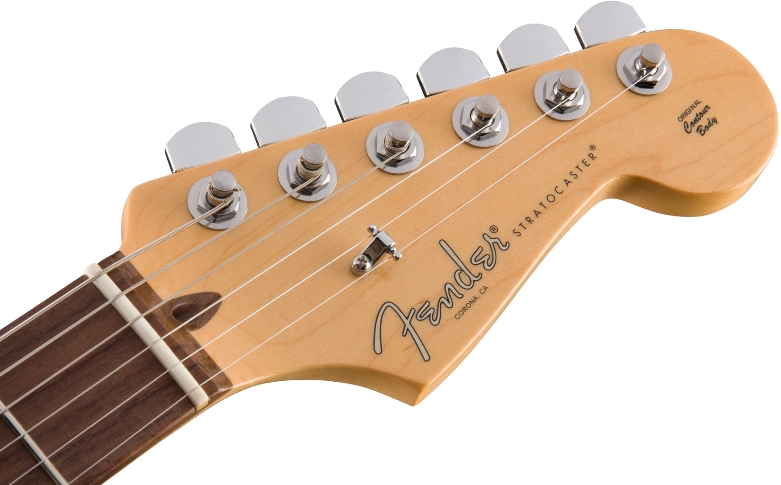
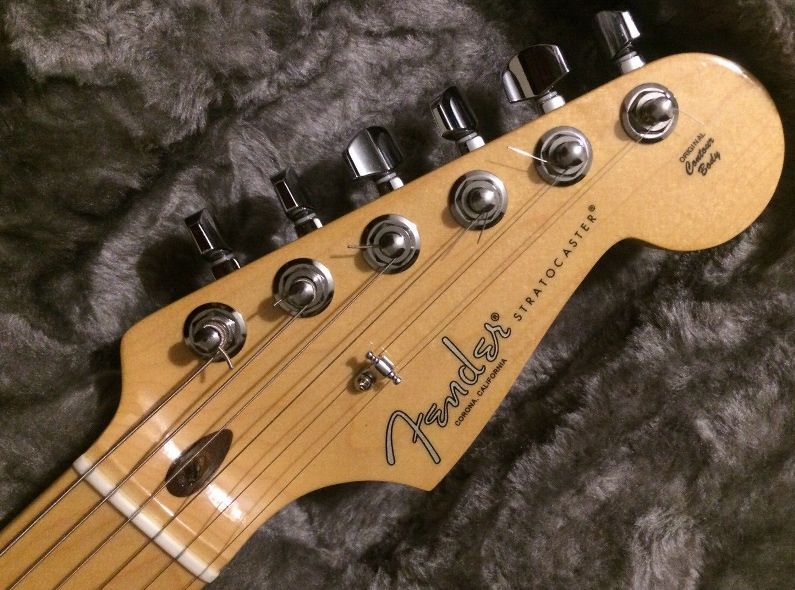
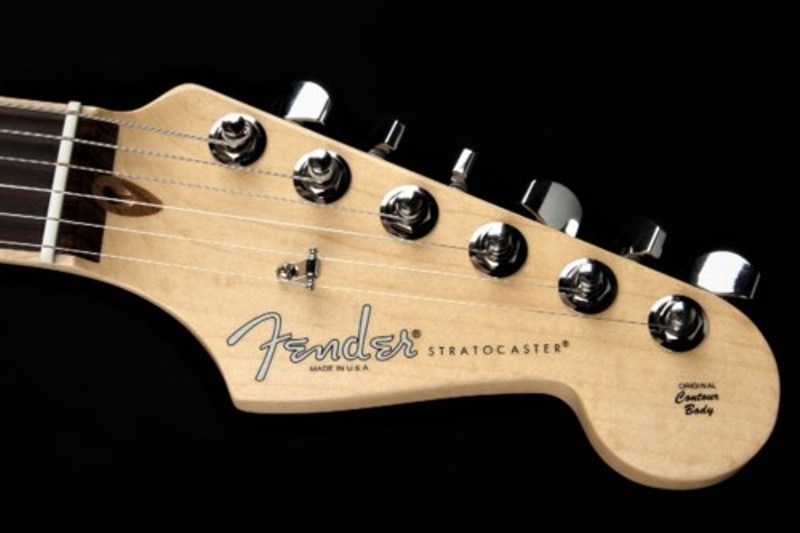
Notes on cases
This information comes from an email sent by Adam Wright in May 2021
I purchased an American Standard in October 1999. I knew what colour I wanted (Olympic White, Maple board) and went to the
local guitar shop and ordered it.
They didn't have any new American Fenders in stock I seem to recall as they were quite a small shop, but they were able to order
one for me. It took a few months to arrive, so I think the distributor may have had to get it from the US.
Anyhow, it arrived and came with a black chainsaw case with the embossed Fender logo rather than the red Fender badge.
The serial number is N8, so 1998. My friend has a 1997 American Standard Stratocaster with the red badged case. So at some point
between 1997 and 1999 the case changed to the Fender embossed logo one.
I still have the guitar, case and invoice to verify this, although the guitar is in for a fret dress at the moment for the first time in 22 years!
I also purchased a Hot Rod Red American Series Stratocaster in 2001 and it came with an identical case.
I sold that one though, but it was by far the better of the two with the upgraded features which you mention.